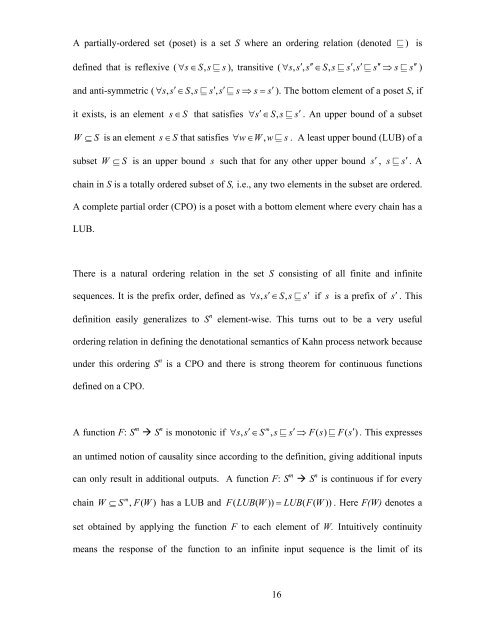Dynamic Dataflow Modeling in Ptolemy II - Ptolemy Project ...
Dynamic Dataflow Modeling in Ptolemy II - Ptolemy Project ...
Dynamic Dataflow Modeling in Ptolemy II - Ptolemy Project ...
Create successful ePaper yourself
Turn your PDF publications into a flip-book with our unique Google optimized e-Paper software.
A partially-ordered set (poset) is a set S where an order<strong>in</strong>g relation (denoted ) is<br />
def<strong>in</strong>ed that is reflexive ( ∀s∈S, s s),<br />
transitive ( ∀ss , ′ , s′′ ∈Ss , s′ , s′ s′′ ⇒s<br />
s′′<br />
)<br />
and anti-symmetric ( ∀ss , ′ ∈Ss , s′ , s′ s⇒ s= s′<br />
). The bottom element of a poset S, if<br />
it exists, is an element s∈ S that satisfies ∀s′ ∈ S, s s′<br />
. An upper bound of a subset<br />
W ⊆ S is an element s∈S that satisfies ∀w∈W, w s.<br />
A least upper bound (LUB) of a<br />
subset W ⊆ S is an upper bound s such that for any other upper bound s′ , s s′ . A<br />
cha<strong>in</strong> <strong>in</strong> S is a totally ordered subset of S, i.e., any two elements <strong>in</strong> the subset are ordered.<br />
A complete partial order (CPO) is a poset with a bottom element where every cha<strong>in</strong> has a<br />
LUB.<br />
There is a natural order<strong>in</strong>g relation <strong>in</strong> the set S consist<strong>in</strong>g of all f<strong>in</strong>ite and <strong>in</strong>f<strong>in</strong>ite<br />
sequences. It is the prefix order, def<strong>in</strong>ed as ∀ss , ′ ∈ Ss , s′<br />
if s is a prefix of s′ . This<br />
def<strong>in</strong>ition easily generalizes to S n element-wise. This turns out to be a very useful<br />
order<strong>in</strong>g relation <strong>in</strong> def<strong>in</strong><strong>in</strong>g the denotational semantics of Kahn process network because<br />
under this order<strong>in</strong>g S n is a CPO and there is strong theorem for cont<strong>in</strong>uous functions<br />
def<strong>in</strong>ed on a CPO.<br />
A function F: S m S n m<br />
is monotonic if ∀ss , ′ ∈S, ss′ ⇒Fs<br />
( ) Fs ( ′ ) . This expresses<br />
an untimed notion of causality s<strong>in</strong>ce accord<strong>in</strong>g to the def<strong>in</strong>ition, giv<strong>in</strong>g additional <strong>in</strong>puts<br />
can only result <strong>in</strong> additional outputs. A function F: S m S n is cont<strong>in</strong>uous if for every<br />
m<br />
cha<strong>in</strong> W ⊆ S , F( W)<br />
has a LUB and FLUBW ( ( )) = LUBFW ( ( )) . Here F(W) denotes a<br />
set obta<strong>in</strong>ed by apply<strong>in</strong>g the function F to each element of W. Intuitively cont<strong>in</strong>uity<br />
means the response of the function to an <strong>in</strong>f<strong>in</strong>ite <strong>in</strong>put sequence is the limit of its<br />
16
















